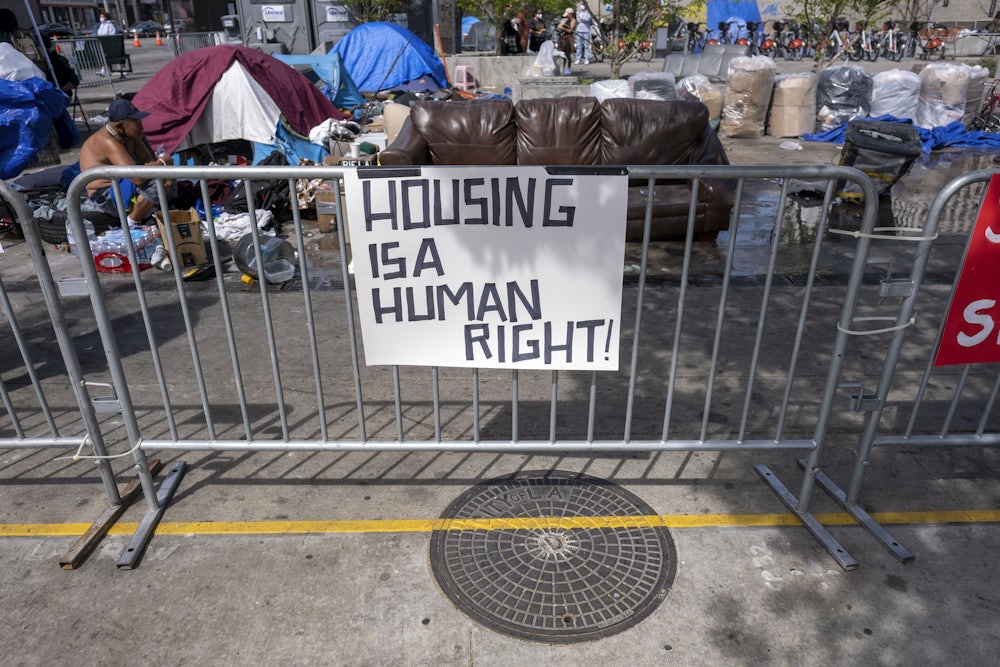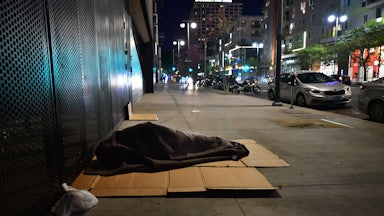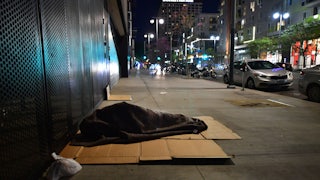Just weeks after results of Los Angeles’s homeless count found that pandemic-related relief programs helped stem the growth of homelessness in the city, the Los Angeles City Council voted to allow evictions to restart in early 2023. Evictions had been taking place all this while despite the protections, but the city’s policy had made it easier for people to stay in their homes if they’d fallen behind on rent. Come February however, several vital programs beyond the city’s imperfect eviction moratorium—including rental assistance and emergency shelters that were created for people already on the street, which helped stem a much-feared Covid-19 spike among unhoused Angelenos—will disappear as federal funds or other money dries out. But there’s a measure on the ballot on November 8 that could not only make renter assistance efforts permanent but help fund new permanent housing.
Next month, Los Angeles has elections that could radically reshape its government. Although most of the attention has centered on the high-profile mayoral race between Representative Karen Bass and billionaire former Republican Rick Caruso, the dominant issue in Los Angeles is homelessness. And on the ballot is Measure ULA, an ambitious and sweeping effort that could reshape the city’s approach to housing and homelessness by funding housing and supportive services for years.
The timing is crucial: Los Angeles is facing a spike in homelessness in 2023 as eviction protections and assistance programs end. That influx will be a huge strain on an already overburdened services network. Moreover, Los Angeles is dealing with a slew of long-term issues—rising home prices and rents, a massive deficit of housing, crowded shelters, and the cessation of affordable housing covenants. The economic impact of the Covid-19 pandemic further exacerbated these problems and put many on the verge of living on the streets.
Measure ULA, advocates say, will forestall this calamity and help prevent people from falling into homelessness via a tax on real estate sales. The measure, if enacted, would place a 4 percent tax on sales or transfers over $5 million and a 5.5 percent tax on sales over $10 million. That money would be used to help fund new affordable housing and acquire properties to become housing.
It would also be used to provide assistance to renters. Approximately 30 percent of the money goes toward rental assistance, from paying seniors and disabled Angelenos to direct rental subsidies. Part of that would also be used to pay for legal counsel for tenants. This assistance couldn’t be more timely. With many affordable housing covenants expiring, seniors and low-income tenants are in danger of losing their long-term homes. Fights such as the struggle over Chinatown’s Hillside Villa apartment complex have already drawn citywide attention.
The ballot initiative was written by a coalition of community organizations, neighborhood activists, and groups working with unhoused people in places such as Skid Row. They argue the plan would not hurt working- and middle-class people and instead only tax those who can afford it.
“Those are the people and corporations who are benefiting hand over fist from the housing market; they are in the best position to help fund these programs,” said Dr. Alexandra Suh, executive director of Koreatown Immigrant Workers Alliance, one of the groups that’s a part of the United to House L.A. coalition. “[The housing crisis] is a problem for the folks who are unhoused, and the folks who are living in daily insecurity and anxiety about not being able to pay rent, and for everyone in L.A. that wants to have a city where people are housed and able to live in our neighborhood,” Suh said. This measure, she contends, presents a “once-in-a-generation chance” to address homelessness.
Measure ULA goes to great lengths to make sure rigorous accountability is applied to this new revenue stream, to ensure it actually flows to those who are in need. The funds and programs would be run through city agencies—for instance, the affordable housing program through the city’s housing department—and there would be a 15-member civilian oversight board to ensure the money is being spent on the programs it was intended to create. That board, which would be appointed by the mayor, would need to be drawn from those with backgrounds in nonprofit housing, construction labor unions, and advocates for disabled people or seniors.
By the city’s own estimates, Measure ULA could generate between $600 million and $1.1 billion annually. A white paper analysis by researchers from Occidental College, the University of Southern California, University of California Los Angeles, and the Southern California Association for Non-Profit Housing found that if it had been in effect the 2021–22 fiscal year, it would have raised more than $900 million.
These types of taxes aren’t new, nor is using them to fund affordable housing. These kinds of policies already exist in Berkeley and Culver City, adjacent to Los Angeles. What makes ULA so ambitious is that it would be a specialized tax rather than a general one, and would fund renter assistance programs on top of everything else. In addition, the nature of Los Angeles’s real estate market means that the money raised from the tax would be a much larger sum than in other cities. According to Shane Philips, housing initiative project manager for UCLA’s Lewis Center for Regional Policy Studies, the implementation of a transfer tax didn’t stop people from buying and selling these high-end properties. The report also found that, despite the measure’s critics’ dire predictions, ULA will not drive up rents.
The ballot measure is undoubtedly the biggest proposal for homelessness in years. The last big push to address the issue in Los Angeles was six years ago, with Proposition HHH. That proposal, a one-time tax on property lots, raised $1.2 billion to help fund new permanent supportive housing. ULA would go further, since in addition to providing seed funding, it would also fund property acquisition and rental support programs, with greater oversight. Suh says that past efforts have been a mixed bag of piecemeal solutions, some effective and some not, and the ones that did work didn’t go far enough in scope. The new measure strikes a contrast by being more expansive; it doesn’t merely address the housing supply problem, it looks further upstream to the root causes of the homelessness crisis itself. Suh also holds that ULA is “the necessary next step” to continue what was done in the pandemic.
“It would be a steady stream of income to draw on long-term,” said Hugo Soto-Martinez, a labor organizer with Unite Here 11 and a progressive City Council candidate currently running against incumbent Mitch O’Farrell for the 13th District seat.
Members of the United for Housing L.A. coalition say the programs and policies contained in ULA have a strong track record. Similar policies that had been in place during the pandemic kept an untold number of people from ending up unhoused: This year’s homeless count, the first since January 2020, found only a 1.7 percent increase in the city, instead of the higher rate that many feared at the outset of the pandemic. Even though many of these programs reached only a fraction of their intended targets, and some—such as the renting of hotel and motel rooms for unhoused people—were marred by complaints about people’s rights being abused, they nevertheless stemmed what was predicted to be a massive surge in pandemic-induced homelessness.
Los Angeles is at a crossroads. The city is much more divided than it was in 2016, when there was a wider push for HHH and its 2017 sister County program Measure H, which funded supportive services. Mayor Eric Garcetti and others expended a lot of political capital to advocate for those proposals. Six years later, the slow rollout of HHH and the worsening crisis have many unhappy with that bond; in the mayoral primary, HHH was often used as a punching bag.
Garcetti, up for an ambassadorship and plagued by scandal, is mostly checked out of city politics. But an increasingly punitive city government—rocked by the disclosure by the Los Angeles Times over the weekend of explosive recordings of some members trafficking in casual racism—has pressed for more sweeps and criminalization of homelessness. The city is divided on how best to address the issue: Some favor proven and time-intensive measures to ameliorate homelessness, but there are increasing demands for the quick fix of dismantling encampments to place the problem out of sight and out of mind. The current City Council expanded a punitive ordinance that bans encampments near schools, parks, libraries, and other locations—essentially most of the city. The upcoming elections could lead to a progressive bloc in the City Council if more incumbents are upset. The next mayor might push for more housing or more policing.
But Measure ULA has its opponents. Business groups, from mall owners to the California Business Roundtable, are putting money into a campaign to stop it. And advocates aren’t getting much from the upcoming election’s mayoral candidates. Bass has not come out for or against it (and her campaign did not respond to a request for comment); she has promised to expand the number of shelter beds and push for more federal funding and housing vouchers.
Caruso, whose plan involves adding thousands more emergency shelter beds and hiring more police, outright opposes ULA. “I think most people would agree that trust in our elected officials is in short supply, especially when it comes to how hard earned tax dollars are used given the fiasco with Prop HHH,” his campaign said in a statement. “While I would support the idea of a dedicated revenue stream for homeless housing and services, I believe we must first demonstrate to the public they can trust the government to utilize these funds effectively and efficiently. That will be my plan from day one, to show voters that they can trust their government to do right by them and their dollars. Once we make that happen, if the need for more funding is proven, I would gladly push forward a measure to make it happen.”
Caruso’s and Bass’s plans are estimated to cost $900 million and $300 million, respectively, but neither are turning to this potential funding source. Meanwhile funding for affordable housing isn’t expected to increase without new sources of revenue, and as advocates stress, temporary shelter is not housing and doesn’t solve the long-term need for new housing.
At the moment, advocates and researchers say they’re optimistic, but they acknowledge that the political climate has shifted substantially since 2016. Along with the bitter mayoral race, the Los Angeles City Council is divided: Many sitting members oppose ULA and prefer more punitive responses to homelessness. Meanwhile the slow rollout of HHH’s units compared to how homelessness grew year over year since 2016 has left many soured.
It should be noted that, despite the criticism that’s been directed at it, HHH actually is on track to meet its goal of 10,000 new units in 10 years. (In the primary, the Caruso campaign called it a tax levied on Angelenos by city government rather than something approved by voters.) The problem is that 10,000 new units wasn’t enough in 2016 and isn’t enough now. The other problem that HHH has faced is that the pandemic and inflation drove up costs, and projects were pitched, approved, and broke ground over time, not all at once, meaning it took some time for these new units to become available.
“In some ways it was a little overly optimistic, that just by raising a bunch of money for supportive and affordable housing, that would be enough to substantially or fully eliminate homelessness,” Phillips said. “Because we didn’t do enough on housing supply, this inflow to homelessness was growing faster than we were growing out of.”
The biggest advantage that ULA enjoys is that, thanks to recent California case law, it won’t require a two-thirds majority of support to pass, like HHH did. It just needs the support of a simple majority. The measure still suffers from an awareness problem, however.
Soto-Martinez acknowledged that there doesn’t seem to be widespread recognition of the ballot measure among the public yet. He and progressive allies are working to overcome this challenge by spreading the word while campaigning, but these efforts are getting somewhat lost in the gravitational pull of the large sums of money being spent by the candidates in the contentious mayoral race.
If ULA does pass, it will not go into effect until spring 2023. Advocates admit that this gap could mean many more people are likely to end up on the streets or in the process of eviction before any of the measure’s features kick in. Nevertheless, they contend that it’s better to have ULA to help people down the line than not have it at all. And Soto-Martinez said that there is some hope that even this interregnum period might not be as dire as the worst-case scenario suggests. Many of the current protections aren’t getting phased out until February. He also said that advocates can help meet the challenge by acting now to identify potential sites for affordable housing projects, as well as properties that could be acquired and turned into housing.
But ULA’s successful implementation, like the homelessness crisis itself, is tied to the upcoming City Council elections. The new City Council will be sworn in mid-December; should ULA pass, it will have the opportunity to take action to step in, during the implementation period, to provide much-needed stopgaps should the shortfalls in services that advocates worry about emerge. But it’ll have a critical role to play in setting ULA for success as well.
Although many parts of the proposal would be carried out via extant city government arms, some new elements—such as right to counsel—would need to be created by the City Council. Phillips said that could take some time, as those programs don’t currently exist outside of their initial pilot form. How swiftly and how effectively ULA’s multitude of provisions are enacted is dependent on whether November’s election results yield an amenable City Council or a hostile one.
In so many ways that matter, ULA’s fate is intertwined with the larger fight for the soul of the city itself. Soto-Martinez says that if the progressive bloc can win its Council races, there is a much better chance that ULA will be implemented in full and quickly. That, he said, could give Los Angeles a brighter future and make the city more affordable to everyone on a long-term basis. And for Suh, the ballot measure is even more meaningful: To her mind, it is the best chance to address one of the biggest human rights issues in the City of Angels.










